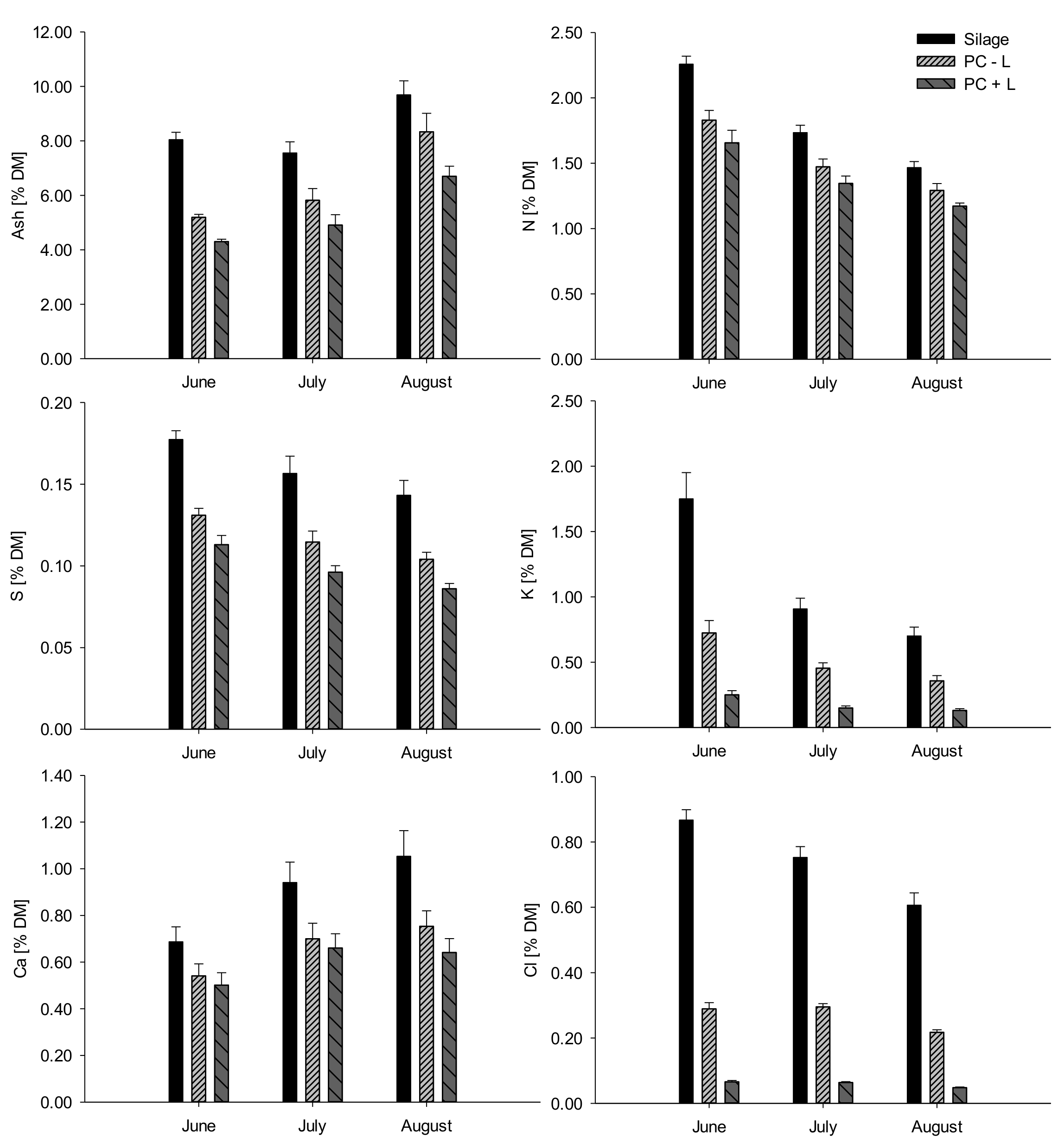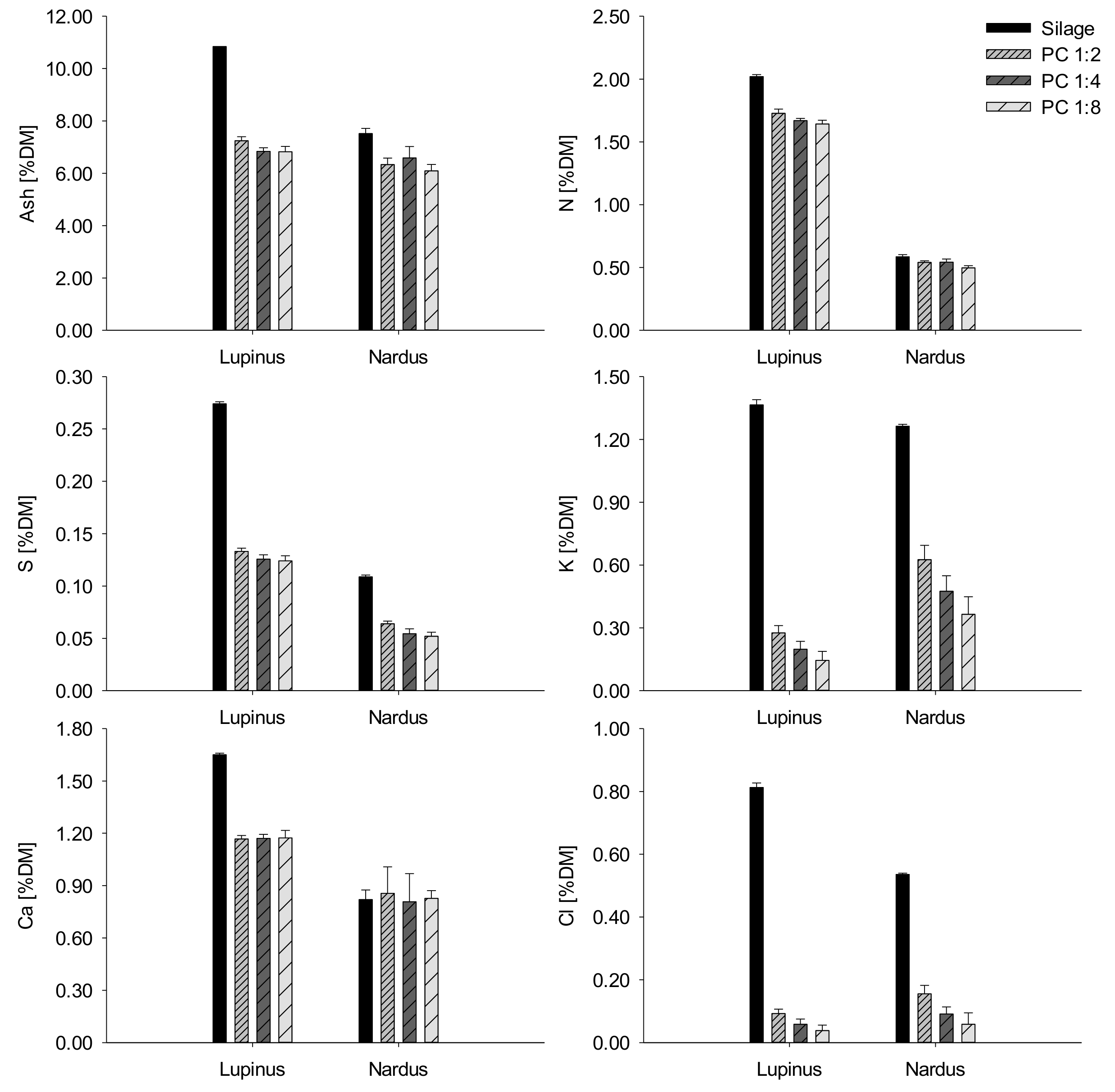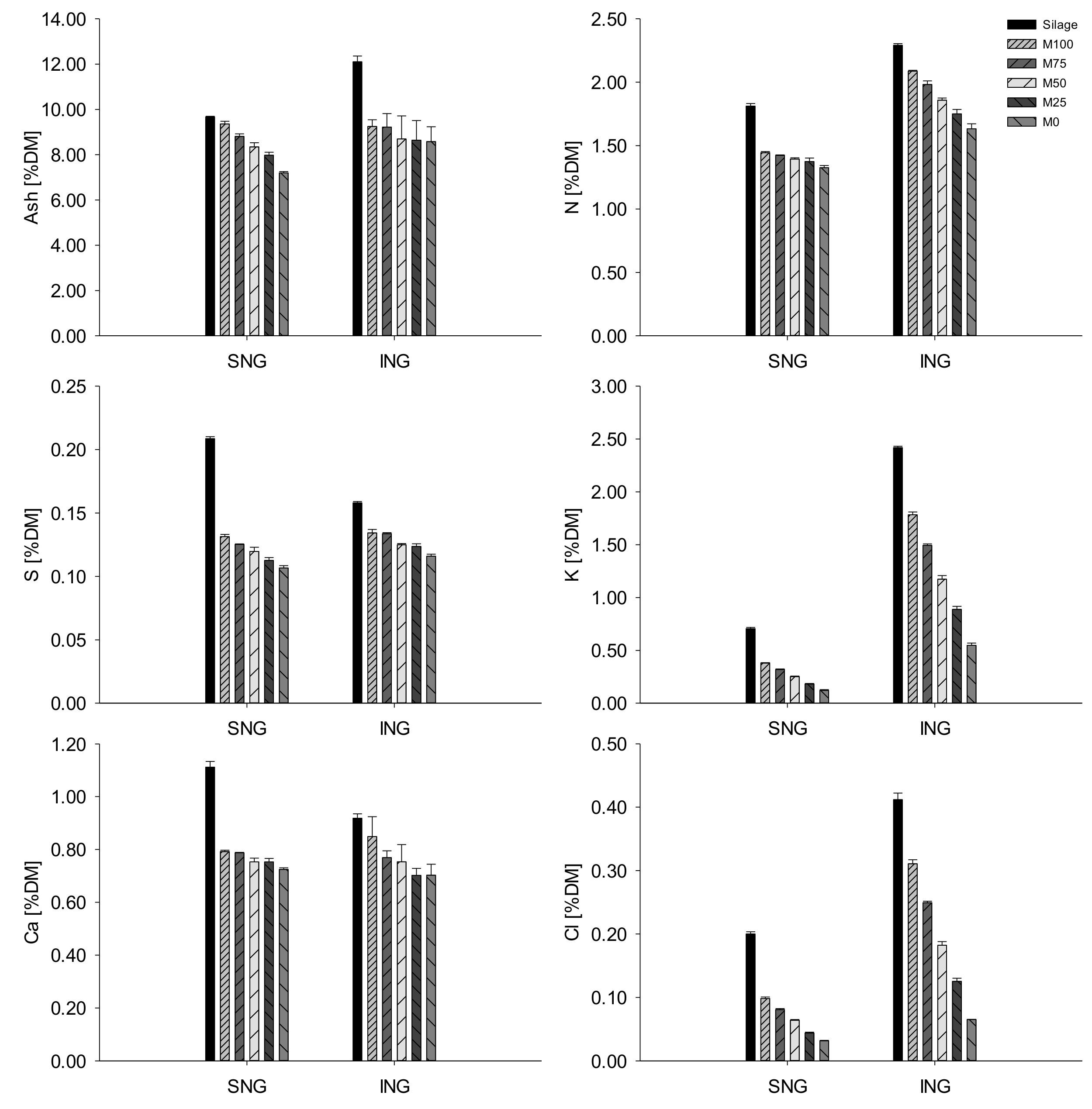1. Introduction
Renewable energies have been proposed as a solution to the huge challenges of the 21st century since they trigger economic growth, provide new jobs, help to mitigate climate change [
1] and are perceived as a clean energy source [
2]. Therefore, political measures have been put in place to subsidize and foster the development of renewable energies, resulting in a rapidly growing contribution of renewable energies to total energy consumption [
3]. Biomass is one of the major sources of renewable energy production worldwide [
4]. However, there are also some negative side effects to the increased production of renewable energy from biomass which threaten its social acceptance [
5,
6]. Studies have shown that the carbon neutrality of bioenergy is debatable, depending on the choice of feedstock, land use-changes, processing methods applied and other indirect effects of removal of biomass for energy production [
7,
8]. In order to produce sustainable renewable energy, biomass should be used that is not suitable for human or animal consumption in adapted energy recovery systems. Such a system was developed by the University of Kassel with the Integrated Generation of Solid fuel and Biogas from Biomass (IFBB) [
9]. IFBB consists of a leaching step followed by mechanical dehydration. The leaching is carried out by putting the biomass into a modified concrete mixer with addition of heated water in a defined ratio for a defined time under permanent mechanical stirring. This step is identical to the step referred to as hydrothermal conditioning in previous publications about the IFBB system. It results in a press liquid (PL) containing the water-soluble parts of the biomass [
10] and a press cake (PC) which has reduced concentrations of mineral elements harmful for combustion and can thus be used as a solid fuel in state-of-the-art combustion units [
11]. IFBB has proven its ability to work with a range of residual biomass types that are currently not used for human consumption or animal forage, but rather are left to decay on the field and roadsides or are composted. The system was tested with biomass from roadside verges [
12], leaves from parks [
13,
14] and streets [
15], horse manure [
16], cuttings from sports fields [
17] and late cuts of semi-natural grassland invaded by the alien plant species
Lupinus polyphyllus [
18]. A life cycle assessment was carried out and proved the sustainability of the IFBB system [
19]. The first step in IFBB is a leaching step, whereby the biomass is submersed in and mixed with warm water, typically at 40 °C and in a ratio of 1 part biomass to 4 parts water, and stirred for 15 min. Hardly any systematic research exists regarding this critical step of IFBB: only Richter et al. [
20] investigated the effects of water temperature. Little is known about the effect of other influential parameters, such as the silage to water ratio or the type of mashing liquid used. Improving the leaching step is of interest for economic reasons, considering the costs of using fresh water, and ecological reasons, e.g., considering the amount of fresh water a commercial IFBB plant would need to produce renewable energy. The present paper aims to close these knowledge gaps by summarizing results of three independent experiments which systematically investigated the leaching step to answer the following three research questions:
How does leaching affect fuel quality?
What is the effect of the silage to water ratio applied in leaching on fuel quality parameters?
What is the effect of using recycled press liquid for leaching instead of fresh water?
3. Discussion
Richter et al. [
22] also investigated the reduction of minerals in press cakes with and without leaching. They found that the concentrations of elements in the press liquid were significantly higher if the biomass was leached before dewatering, corresponding to higher mass flows of elements into the PL [
22]. Thus, the higher reduction rates of elements in the PC with leaching found in the current study confirm these findings. Concerning the date of harvest, the present results are not fully comparable with those of Richter et al. [
22], as the harvest dates in that study were earlier (April–June). Nevertheless, they also found that material from the earlier sampling dates showed a higher mass flow of minerals and N into the press liquid, resulting in higher reduction rates for those elements in the press cake. This higher reduction may be attributed to plant tissue being softer at earlier stages of crop maturity, which may particularly apply to N, as it predominantly occurs in the form of structurally insoluble proteins at later stages of maturity [
23]. However, Corton et al. [
24] also investigated the IFBB system with and without leaching and found no difference in the reduction of ash, K, Mg, Na, and P. This might be explained by the fact that Corton et al. [
24] used a different leaching set-up (i.e., cold water added directly into the screw press) compared to most other IFBB studies. Furthermore, they used a special plant biomass, from
Juncus effusus dominated grasslands.
Juncus effusus has a water-repellent outer layer which may explain the lower reduction rates found by Corton et al. [
24].
According to Obernberger et al. [
25], guiding concentrations of N, Cl and S for unproblematic combustion are <0.6%, <0.1% and <0.1% DM, respectively. The guiding value could not be reached for N, irrespective of the type of treatment or date of harvest. However, this does not necessarily lead to problems with NO
x emissions if appropriate biomass combustion units equipped with air or fuel staging are used [
26,
27]. Considering Cl, values only stayed below the guiding value if a leaching step was applied. In case of S, concentrations below the guiding value were achieved for the later harvest dates (July and August) with leaching. The results show that leaching plays a crucial role within the IFBB system to produce a press cake with acceptable mineral concentrations: without leaching, the resulting press cake will not have the adequate quality for use as a solid fuel. These findings also have relevance for other thermo-chemical processes, such as pyrolysis, as they have similar demands considering the feedstock quality [
28,
29]. However, the chemical composition analysis can only be the first step of an investigation of the combustion quality of a fuel. Combustion tests should be carried out and emissions measured. This was done for the IFBB PC for example by Bühle et al. [
30], showing that the treatment of semi-natural grassland biomass led to increased performance in terms of increased ash deforming temperatures. Khalsa et al. [
14] also performed combustion tests with pellets made from foliage and grass samples that were treated with a leaching and subsequent dewatering treatment comparable to the IFBB treatment. The resulting emissions were in accordance with German legal thresholds for CO emissions, but slightly above threshold values for NO
x emissions occurred for the grass based fuels, but not for the foliage based fuels. The emission tests highlighted the need for a filter to reduce particulate matter emissions.
Furthermore, the results showed higher mineral reduction rates with increased shares of fresh water used in leaching. Tonn et al. [
31] investigated the effect of leaching on semi-natural grassland biomass and found significant concentration reductions for Cl, K, S, Mg and ash. These reductions increased with the amount of water used in the experiments, as well as with the time the biomass was exposed to the leaching treatment. K and Cl were the elements that showed the greatest reduction through leaching, which is due to the fact that these elements are present in plants in their ionic forms [
32] and, thus, can be easily leached. In the present experiment, results below the guiding values for combustion proposed by Obernberger et al. [
25] could not be achieved for every biomass and silage to water ratio. The N concentration in the silage dominated by
Lupinus was high and the IFBB treatment did not lead to a high enough reduction to reach the target value of 0.6, whereas the
Nardus-dominated silage and the resulting PCs produced at all silage to water ratios were below the critical value. For the Cl concentration, the ratio of silage to water made a crucial difference: for the
Nardus-dominated biomass, only the PCs at the 1:4 and 1:8 ratio achieved concentrations below the guiding value. Thus, the concentrations of elements in the original biomass has a strong influence on whether an adequate fuel quality can be achieved, but using larger shares of fresh water helped to reduce the mineral concentrations. However, the achievement of relatively small improvements in fuel quality with higher amounts of fresh water used have to be weighed against the higher costs and ecological impacts of an increased water consumption. There is a need for further research on the question of the optimal silage to water ratio from the economic and ecological point of view.
The liquids used for leaching (i.e., press liquids of ING or SNG silages and fresh water) were very different in chemical composition, which is due to the fact that the press liquids contained minerals that were extracted from the initial biomass. This resulted in lower reduction rates through leaching when press fluids were used instead of fresh water, as the solubility of minerals in a solution depends, among other factors, on the concentration of minerals already dissolved in the liquid. Comparable experiments using the press liquid as a leaching solution were carried out by Graß et al. [
33] for wheat silage. They also found lower reduction rates for ash and N, but no significance difference for K if press liquid was used instead of fresh water. The concentrations of minerals in the press cakes produced by Graß et al. [
33] with fresh water were tentatively lower than those produced using press liquid. Regarding the present study and concerning the suitability of the produced press cake as a solid fuel, it has to be stated that although a reduction in mineral concentrations was achieved with IFBB for both biomass types and all leaching liquids, the values for N and S were above the guiding values for unproblematic combustion [
25]. In the case of Cl, the concentrations in the SNG PC were below the guiding value for all leaching liquids except the pure PL. For the ING PC, only mashing with pure water achieved Cl concentrations below the guiding value. Thus, it can be concluded that a pure water leaching is more likely to achieve adequate solid fuel qualities with a wider range of input materials than a press fluid leaching.
The 2S/Cl ratio is described in detail by Sommersacher et al. [
21]. It was shown that the molar 2S/Cl ratio is an indicator for high-temperature corrosion risk. Sommersacher et al. [
21] stated that if fuels have a 2S/Cl ratio >4, only minor risk of corrosion is to be expected, and if the ratio is >8, corrosion risk is negligible. The values found in the silages were below 1, indicating a high risk of corrosion due to high Cl concentrations. As Cl is easily soluble in water, it was washed out to a greater extent than S, which led to increased 2S/CL ratios in the PC. Experiment 1 showed that the reduction of Cl achieved with the leaching step was much higher than without such a treatment. Thus, the PC+L had a higher ratio and lower corrosion risk, while the risk for the PC-L was still high. When more water was added in Experiment 2, the increase to the wash-out rate of Cl was higher than the increase to the wash-out rate of S, leading to an even higher 2S/Cl ratio. This means a decreased risk of corrosion with increased water addition to the silage, resulting in PC with low risk of corrosion for water to silage ratios of 1:4 and 1:8, but not for 1:2. Experiment 3 showed that using pure water (M0) was superior in reducing S and Cl in comparison with partial or pure PL (M25-M100). Again, the wash-out rate of Cl was higher than that of S, leading to a high increase in the 2S/Cl ratio for the pure water treatment (M0) with low risk of corrosion and a small increase in the 2S/Cl ratio but still high risk of corrosion for the pure PL (M100). The results of the 3 experiments with regard to risk of corrosion can be summarized as follows: The risk of corrosion is lower with leaching, and lower still if pure water is used in a ratio of silage to water of 1:4 or 1:8.








